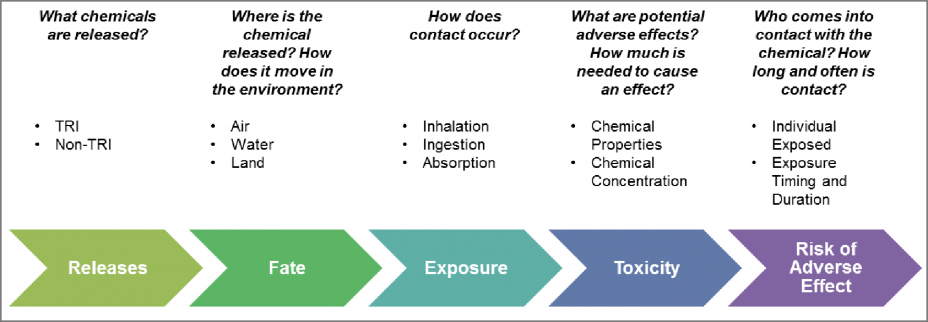TRI and RSEI for Communities
On this page:
- RSEI Scores
- What does a high RSEI Score mean?
- How is a RSEI Score different from TRI Pounds Released?
- Getting started with RSEI
EPA's Risk-Screening Environmental Indicators (RSEI) model can provide important information about the potential health-related impacts of toxic releases from facilities in your community that report to the Toxics Release Inventory (TRI). RSEI brings together large amounts of complex information and provides easier-to-use results for screening, prioritizing and analyzing trends.
RSEI Scores
RSEI Scores are numbers to use for comparison and ranking. RSEI Scores are calculated by chemical, by facility or industry, or by geographic area. You can add RSEI Scores together - the RSEI Score for a facility is the same as the sum of all the RSEI Scores for the releases from the facility. RSEI Scores are relative, which means a RSEI Score 10 times higher than another RSEI Score suggests that the potential for risk is 10 times greater.
RSEI Scores do not describe a level of risk (such as the number of excess cancer cases), and should not be used to draw conclusions about risk. RSEI Scores should only be used to identify situations of potential concern. Additional investigation should always be performed before any conclusions regarding risk are made.
What does a high RSEI Score mean?
High RSEI Scores (relative to other RSEI Scores) can be used to identify areas that may warrant further investigation. High RSEI Scores do not conclusively demonstrate sources of risk. If a facility receives a high RSEI Score, it does not necessarily mean that the facility is harming people around it, or that the facility is not following applicable laws and regulations. If your community, or a facility in your community, has high RSEI Scores, you could use that information to help you decide if and what kind of further investigation is warranted. You can browse additional sources of environmental information to help assess situations of potential concern.
A low RSEI Score indicates low potential concern from reported TRI releases, but other kinds of environmental risk may still be present that are not related to TRI releases, including, for example, pollution from mobile sources like cars and trucks and unreported releases from facilities.
How is a RSEI Score different from TRI Pounds Released?
TRI provides data about environmental releases of toxic chemicals from industrial facilities throughout the United States, measured in pounds. However, the quantity of releases does not indicate the level of health risk posed by the chemicals. The human health risk resulting from exposure to toxic chemicals is determined by many factors, as shown in the figure below. TRI contains some of this information, including what chemicals are released from industrial facilities; the amount of each chemical released; and the amounts released to air, water, and land.
Additional information can provide more context for releases reported to TRI, as shown in the graphic below. The TRI Program uses RSEI to provide information environmental fate, exposure and toxicity information. RSEI adds important information about relative potential for risk, but it cannot determine individual exposure or actual risk.
 Overview of Factors that Influence Risk
Overview of Factors that Influence Risk
It is important to keep in mind that while TRI often includes information on a large portion of the toxic chemicals used by industry, it does not cover all facilities, all toxic chemicals, or all sources of TRI chemicals in communities. For example, potential sources of chemical exposure that are not covered by TRI include exhaust from cars and trucks, chemicals in consumer products, and chemical residues in food and water. More information on other sources of environmental risk not considered in RSEI.
Getting started with RSEI
You can look at RSEI Scores by state, county and facility on the RSEI results map.
You can also get RSEI information on the facilities in your community by using the search tool at the bottom of this page. Type in your ZIP code or city and state and click the magnifying glass to bring up the Envirofacts TRI viewer for your community. The extent of the map can be adjusted. If you click the “List and Map Facilities Reporting in this View,” a list of facilities will appear. Facilities with RSEI results will show “Report” in the Risk Screening column. Click on “Report” to see the RSEI results for that facility.

Enter a place name or ZIP code in the box below to bring up a map of facilities in a separate window.
